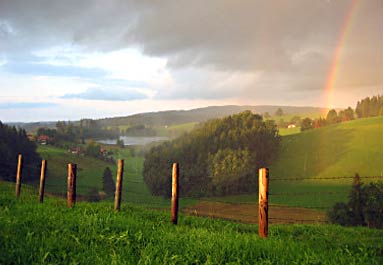This original column is provided free for one-time use with author credit at the end. It may be used for background with author credit. Copyright applies.
#15 FOR IMMEDIATE RELEASE: December 20, 2007
Land buyers need answers to environmental questions
By Curtis Seltzer
BLUE GRASS, Va.—Many land buyers judge the book they’re considering by its cover. Don’t. A property that looks fine through your windshield may be a mess under your microscope. Environmental problems can be hidden. But just as often they go unrecognized despite being in plain sight.
Some of the most common environmental issues that country buyers encounter include:
What will be? Buyers planning to hold property for a decade or more might give a moment’s thought to how global warming might impact the land they’re investigating. Depending on what the world’s nations do to reduce greenhouse gases, the consensus projection of global temperature increase is an average of two to 13 degrees F by 2100. Land in the northern latitudes would be most affected, and much of the impact would be expressed in warmer winters. Anyone planning to pass agricultural or forested land to heirs who themselves might pass it along should think through how a ten-degree warmer future would change the property’s suitability for its current crops and trees, as well as patterns of precipitation and weather. Click here for Regional forecasts.
Weather. Different areas are prone to fairly predictable catastrophic events, such as tornados, hurricanes, droughts, forest fires, hail, lightning, late frosts, floods and so on. If you’re new to an area, you need to find out if the seller’s property sits on a bull’s-eye.
Climate change will alter the geographical distribution, severity and prevalence of such events. See www.epa.gov/climatechange/; click on Extreme Events.
Click Here for a national hurricane map. Click Here for a shaking-hazard (earthquake) map. Click Here for Landslide maps from the U.S. Geological Survey’s Landslide Information Center.
Aspect. This refers to the compass direction that sloped land faces. On flat land,
aspect does not matter. In rolling-to-mountainous country, aspect helps to determine the productivity of soils for agriculture and timber growth. The best and fastest-growing timber shows up on north-facing slopes where it is coldest and wettest; southern aspects grow timber and pasture less efficiently.
Soils 1. The buyer needs to determine whether the seller’s ground is stable for his intended uses. Landslides, earthquakes and sinkholes are better avoided.
Soils 2. Dirt varies in quality, properties and suitability. A county’s Soil Survey has maps and information that show a buyer what a seller’s dirt can do. Go to http://soils.usda.gov and http://websoilsurvey.nrcs.usda.gov/app/. Print copies of the Soil Survey are free from the county office of the USDA’s Natural Resources Conservation Service.
Rocks. Big boulders, ledges and outcrops indicate hard-to-dig-in ground. Check the soil maps for the degree of stoniness. If you doubt the soil map, dig a couple of large, deep holes; nothing beats field-truthing opinion.
Steepness. The steeper the land, the less useable and less stable it is.
Water. The seller’s water resources need to be evaluated for both quantity and quality. Buyers can get a quick idea about local surface-water resources at http://water.usgs.gov/GIS/huc.html. Click on “Surf Your Watershed.” A stream-flow map, shows current flow against historical data. Some water pollutants occur naturally, such as iron and sulfur. Others originate with chemicals, petroleum products, fertilizers and mineral contaminants, either onsite or off. Ask the seller what chemicals he’s used on his land, where he stored chemicals and petroleum products, where he washed his equipment and whether he’s ever tested his water. All water sources on rural property should be lab tested prior to making an offer.
Floodplain. Low-lying land next to watercourses will be flooded sooner or later. Floodplain maps and related information are available from the Federal Emergency Management Agency. Buyers should also check with local building and environmental officials about the flooding history of a particular tract. Some locales prohibit construction in floodplain.
ETS species. Endangered, threatened and sensitive (ETS) species and their habitats are federally protected. Of the 1,272 U.S. species listed as endangered or threatened at the end of 2005, 471 were designated as having “critical habitat.” ETS restrictions on use of private lands are in place, though landowners may gain exceptions in some circumstances.
Start at http://www.fws.gov/endangered/wildlife.html. Click on Landowner Tools and Maps, which list species for each state. Most states have natural heritage offices that may be willing to show you a habitat map, or at least tell you whether your target property is likely to provide ETS habitat. Also contact the nearest office of the U.S. Fish and Wildlife Service.
Nuisance species. I like a toothy little beaver as much as the next guy, but they can damage land and trees even as they provide certain environmental benefits. Deer, coyotes, prairie dogs, snakes, alligators and other creatures can damage trees or crops, or present a safety hazard to humans, livestock and pets.
Troublesome bugs, diseases and weeds. The county extension agent should know which crops in which areas are attacked by the usual suspects. Preventive measures, both organic and non-organic, are available for crops.
Trees bear similar afflictions. The state’s county forester will know about infestations and their level of threat. Some forest hazards cannot be prevented or treated.
Toxic vegetation. Livestock can be poisoned by a number of species of plants, shrubs and trees. Ask the seller to disclose what he knows and double check with a local vet and the county extension agent.
Nuisance vegetation. Woods, fields and cropland are vulnerable to hard-to-kill plants that engage in hostile takeovers and boss everybody around. Walk the seller’s ground with a local farmer or county extension agent.
Wetlands. A number of federal restrictions and prohibitions apply to what landowners can do with wetlands, the definition of which is very broad.
Wetlands inventory is available at http://www.fws.gov/nwi/; click on Wetlands Mapper.
Buried treasures. The seller’s land may contain graves or resources related to paleontology or archeology—any of which may limit what a landowner can do with his property.
Navigable waterways and protected streams. The federal definition of navigable waterways extends to headwaters of rivers that may be bone dry most of the year. Permission from the Army Corps of Engineers is required for any excavation in these waters. Channeling is prohibited even where it will reduce flood damage. Landowners are also limited about what they can do in and next to high-quality protected streams.
Dumps, piles and heaps. Household trash is unsightly but usually benign. Mine refuse heaps can leach acid and other contaminants into water resources. Be suspicious on any rusting 55-gallon drums of unmarked stuff. Make sure that the seller disposes of these materials prior to closing—and that you observe him doing so.
It’s sometimes useful to include a requirement in a purchase offer that the seller
disclose any environmental condition that would adversely affect the buyer’s possession, use or enjoyment of the property. Land, like a book, is best judged by its content, though covers are important too.
Curtis Seltzer, land consultant, is the author of How To Be A DIRT-SMART Buyer of Country Property at www.curtis-seltzer.com. He holds a Class A residential contractor’s license in Virginia and has lived in a now 90-year-old farmhouse for 25 years.
Contact: Curtis Seltzer, Ph.D.
Land Consultant
1467 Wimer Mountain Road
Blue Grass, VA 24413-2307
540-474-3297
curtisseltzer@htcnet.org
www.curtis-seltzer.com
This original column is provided free for one-time use with author credit at the end. It may be used for background with author credit. Copyright applies.
|









